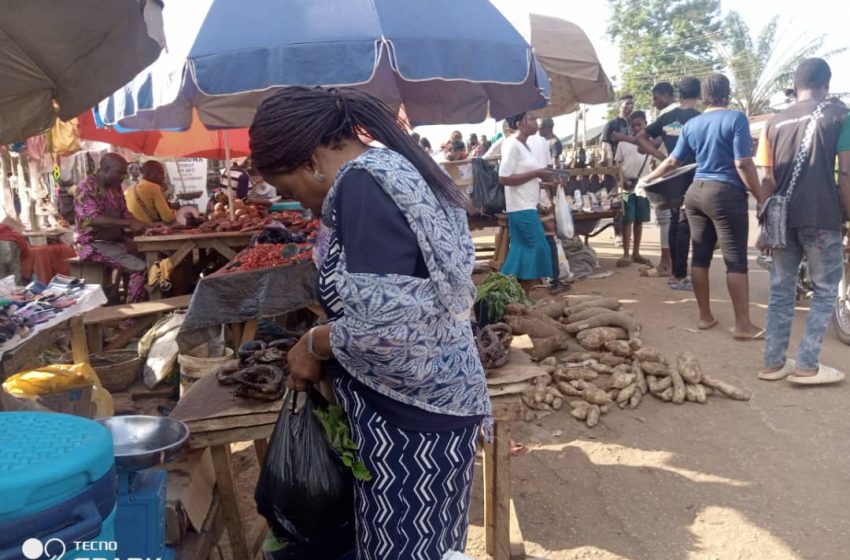According to the latest figures from the National Bureau of Statistics, Nigeria’s Consumer Price Index rose to 15.92 percent in March 2022. This new figure was the highest the country has recorded since November 2021.
In the first quarter of the year, Nigeria’s inflation rate grew from 15.60 percent in January to 15.92 recorded in March. This is a percentage growth of 0.32% within the space of three months.
The NBS in its “CPI report for March 2022” revealed that Nigeria’s inflation fell by 2.25 percent when compared to 18.7 percent in March 2021 but was 0.22 percent higher than 15.70 per cent recorded in February.
The report said, “In March 2022, the consumer price index, which measures inflation, increased to 15.92 percent on a year-on-year basis.
“This is 2.25 percent points lower compared to 18.17 percent, the rate recorded in March 2021. This means that the headline inflation rate slowed down in March 2022 when compared to the same month in the previous year.
“Increases were recorded in all COICOP divisions that yielded the headline index. On a month-on-month basis, the headline index increased to 1.74 percent in March 2022, this is 0.11 percent points higher than the rate recorded in February 2022 (1.63 percent).”
Beyond the statistical figures of NBS, a survey conducted shows that the Nigerian traders, including patronizers of the market, are sharing in the pain of skyrocketed prices on food products. The survey revealed that prices of most food products increased by 100% in the last two year despite the inflation rate dropping in the last quarter of 2021 before increasing in the first quarter of 2022.
Similarly, a report by SBM Intelligence, published that the continuous insecurity challenges, sit-at-home order and recent hike in fuel are major indicators that increased the prices of foodstuffs in the first quarter of 2022.
The report, titled ”Jollof Index Q4 2021 & Q1 2022 showed that the average cost of making a pot of jollof rice for a family of five rose from N8,007 in Q3 2021 to N8,595 at the end of Q1 2022 — a 7.3 per cent increase.
Why the increase?
Several predictions ranging from the restriction on foreign exchange policies, devaluation on naira, the ongoing war between Ukraine and Russia, scarcity of petroleum as well as several insecurity issues in the country are enlisted as the possible reason for increase in inflation rate in the first quarter of the year.
Recall that the NBS said the total international trade in agricultural goods in the country stood at N3.24tn in 2021, with the import value exceeding export value by N2.23tn. This came despite the interventions by the Federal Government to diversify the economy and increase food production in the country.
Also, in 2015, the nigerian government as classified about 15 products on its foreign exchange restriction as part of an effort to strength the country’s foreign reserves and grow the patronage of local productions in the country
However, the World Bank warned that import restrictions and the Central Bank of Nigeria’s foreign exchange policies are the main drivers of food inflation in Nigeria.
The World Bank said, “Rising food prices are the underlying factor behind the surge of headline inflation in Nigeria. Food prices have increased due to import restrictions and a nonflexible exchange rate management.”
“The current regime is keeping the official exchange rate of the naira artificially strong while the naira has weakened significantly on the parallel market. Additionally, the central bank has restricted importers’ access to foreign currency for 45 products and has reduced the supply to other importers,” the bank added.
On the other hand, the value of naira has continued to depreciate in the parallel market as the exchange rate is climbing about N580/$1.
An economist and the Chief Consultant of Biodun Adedipe Associates Consult, Biodun Adedipe, said the government must discard the “Business as Usual” approach to fiscal management.
“Inflation in Nigeria is not in crisis, as it started trending downwards in April 2021, but there are concerns about the dampening effect of food inflation. The food challenge has worsened by the level of insecurity across the food belts in the nation. A case example is 1kg of beans which increased by 44.64% between 2021 and 2022.”
Highlight of Q1 Inflation Rate In Five Year
- For three consecutive years, between 2020 and 2022, inflation rate has consistently increased in the first quarter.
- In 2018, the inflation rate dropped from 15.13 percent in January to 13.34 percent In March; compared to 2019, where the inflation rate was 11.37 percent in January and dropped to 11.25 percent in March.
- In 2020, the inflation rate grew from 12.1 percent in January to 12.26 percent In March; compared to 2021, where the inflation rate was 16.47 percent in January and increased to 18.17 percent in March.
- By quarter, the inflation rate dropped by 1.79% in 2018 and 0.12% in 2019.
- It however, grew by 0.16% in 2020; 1.7% in 2021 and 0.32% in 2022.
- Nigeria had the sharpest growth of inflation rate in 2021; while it had the sharpest drop in 2018.
- Comparing years, Nigerians experienced a relief, according to data, in 2018 and 2019 first quarter.
- Inflation rate climbed faster in 2021 and 2022. Reasons could be tied to the impact of COVID-19, foreign policies, fuel scarcity and internal security crises.

